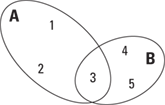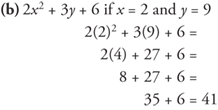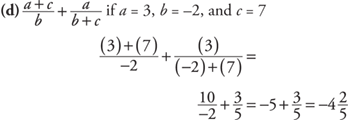Chapter 3
Terminology, Sets, and Expressions
Chapter Check-In
 Set theory
Set theory
 Algebraic expressions
Algebraic expressions
 Evaluating expressions
Evaluating expressions
Understanding the language of algebra and how to work with algebraic expressions gives you a good foundation for learning the rules of algebra.
Set Theory
A set is a group of objects, numbers, and so forth. {1,2,3} is a set consisting of the numbers 1,2, and 3. Verbally, “3 is an element of the set {1,2,3}.” To show this symbolically, use the symbol  , which is read as “is an element of” or “is a member of.” Therefore, you could have written:
, which is read as “is an element of” or “is a member of.” Therefore, you could have written:
3  {1,2,3}
{1,2,3}
Special sets
A subset is a set contained within another set, or it can be the entire set itself. The set {1,2} is a subset of the set {1,2,3}, and the set {1,2,3} is a subset of the set {1,2,3}. When the subset is missing some elements that are in the set it is being compared to, it is a proper subset. When the subset is the set itself, it is an improper subset. The symbol used to indicate “is a proper subset of” is  . When there is the possibility of using an improper subset, the symbol used is
. When there is the possibility of using an improper subset, the symbol used is  . Therefore, {1,2}
. Therefore, {1,2}  {1,2,3} and {1,2,3}
{1,2,3} and {1,2,3}  {1,2,3}. The universal set is the general category set, or the set of all those elements under consideration. The empty set, or null set, is the set with no elements or members. The empty set, or null set, is represented by
{1,2,3}. The universal set is the general category set, or the set of all those elements under consideration. The empty set, or null set, is the set with no elements or members. The empty set, or null set, is represented by  , or { }. However, it is never represented by {
, or { }. However, it is never represented by { }.
}.
Both the universal set and the empty set are subsets of every set.
Describing sets
Rule is a method of naming a set by describing its elements.
{x:x > 3, x is a whole number} describes the set with elements 4, 5, 6,…. Therefore, {x:x > 3, x is a whole number} is the same as {4,5,6,…}. {x:x > 3} describes all numbers greater than 3. This set of numbers cannot be represented as a list and is represented using a number line graph, which is discussed in Chapter 8.
Roster is a method of naming a set by listing its members.
{1,2,3} is the set consisting of only the elements 1,2, and 3. There are many ways to represent this set using a rule. Two correct methods are as follows:
{x:x < 4, x is a natural number}
{x:0 < x < 4, x is a whole number}
An incorrect method would be {x:0 < x < 4} because this rule includes ALL numbers between 0 and 4, not just the numbers 1, 2, and 3.
Types of sets
Finite sets have a countable number of elements. For example, {a,b,c,d,e} is a set of five elements, thus it is a finite set. Infinite sets contain an uncountable number of elements. For example, {1,2,3, …} is a set with an infinite number of elements, thus it is an infinite set.
Comparing sets
Equal sets are those that have the exact same members — {1, 2, 3} = {3, 2, 1}. Equivalent sets are sets that have the same number of members — {1, 2, 3} ∼ {a, b, c}.
Venn diagrams (and Euler circles) are ways of pictorially describing sets as shown in Figure 3–1.
Figure 3–1 A Venn diagram

The A represents all the elements in the smaller oval; the B represents all the elements in the larger oval; and the C represents all the elements that are in both ovals at the same time.
Operations with sets
The union of two sets is a set containing all the numbers in those sets, but any duplicates are only written once. The symbol for finding the union of two sets is  .
.
Example 1. Find the union {1,2,3}  {3,4,5}.
{3,4,5}.
{1,2,3}  {3,4,5} = {1,2,3,4,5}
{3,4,5} = {1,2,3,4,5}
The union of the set with members 1, 2, 3 together with the set with members 3, 4, 5 is the set with members 1, 2, 3, 4, 5.
The intersection of two sets is a set containing only the members that are in each set at the same time. The symbol for finding the intersection of two sets is  .
.
Example 2. Find the intersection {1,2,3}  {3,4,5}.
{3,4,5}.
{1,2,3}  {3,4,5} = {3}
{3,4,5} = {3}
The intersection of the set with members 1, 2, 3 together with the set with members 3, 4, 5 is the set that has only the 3.
If you were to let the set with {1,2,3} be set A, and the set with {3,4,5} be set B, then you could use Venn diagrams to illustrate the situation (see Figure 3–2).
Figure 3–2 Intersection of set A and set B

The union will be all the numbers represented in the diagram, {1,2,3,4,5}.The intersection would be where the two ovals overlap in the diagram, {3}.
Example 3. Find {1,2,3}  {4,5}.
{4,5}.
Since there are no members that are in both sets at the same time, then {1,2,3}  {4,5} =
{4,5} =  .
.
The intersection of the set with members 1, 2, 3 together with the set with members 4, 5 is the empty set, or null set. There are no members in both sets at the same time.
Variables and Algebraic Expressions
A variable is a symbol used to denote any element of a given set—often a letter used to stand for a number. Variables are used to change verbal expressions into algebraic expressions.
Example 4: Give the algebraic expression.
|
Verbal Expression |
Algebraic Expression |
|
The sum of a number n and 7 |
n + 7 or 7 + n |
|
The number n diminished by 10 |
n – 10 |
|
Seven times the number n |
7n |
|
x divided by 4 |
|
|
Five more than the product of 2 and n |
2n + 5 or 5 + 2n |
|
Seven less than the quotient of y and 4 |
|
• Key words denoting addition:
sum
larger than
enlarge
plus
gain
rise
more than
increase
grow
greater than
• Key words denoting subtraction:
difference
smaller than
lower
minus
fewer than
diminish
lose
decrease
reduced
less than
drop
• Key words denoting multiplication:
product
times
of
multiplied by
twice
• Key words denoting division:
quotient
ratio
divided by
half
Evaluating Expressions
To evaluate an expression, just replace the unknowns with grouping symbols, insert the value for the unknowns, and do the arithmetic, making sure to follow the rules for the order of operations.
Example 5: Evaluate each of the following:





Chapter Check-Out
1. {2,4,6}  {2,3,4} =
{2,3,4} =
2. {3,4,5}  {5,6,7} =
{5,6,7} =
3. True or False: {5,6}  {1,3,5}
{1,3,5}
4. Express algebraically: six more than three times a number n.
5. Evaluate: 6x2y if x = –2 and y = 4.
6. Evaluate:  if a = 5, b = –1, and c = 3.
if a = 5, b = –1, and c = 3.
Answers: 1. {2,4} 2. {3,4,5,6,7} 3. False 4. 3n + 6 5. 96 6. 0

